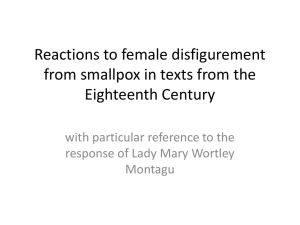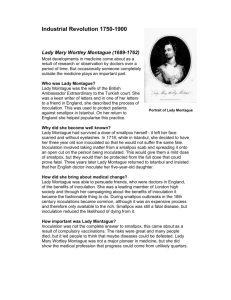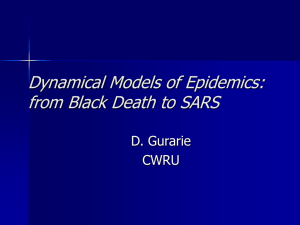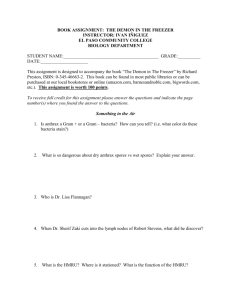smallpox2010
advertisement
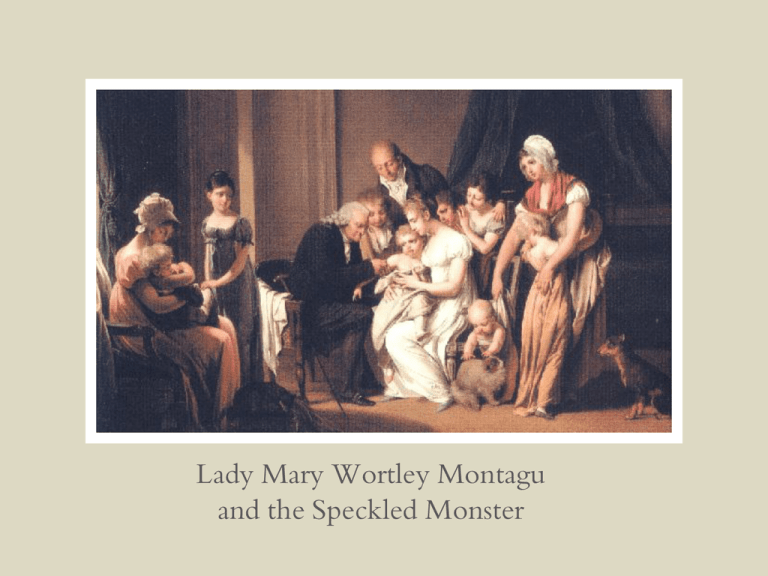
Lady Mary Wortley Montagu and the Speckled Monster 18th Century Europe •Entered the Age of Reason •Enlightenment •Intelligence and reason over ignorance and superstition •Optimism •Emphasis on Scientific Methods 18th Century Europe • Baroque-extravagant, dramatic, complex • Rococo-free, fluid, feminine • Classical-clean, articulate, orderly The Adoration of the Magi (1624), Peter Paul Rubens Pilgrimage on the Isle of Cythera (1717), Antoine Watteau Women in 18th Century Europe • Authors and poets – Only aristocrats – And only anonymously • Using male name • Still had place as the “more fragile” of genders Social & Economic Divide Poor lived in shacks, packed into deserted houses. The wealthy had power over politics, land. Showed status in sprawling country estates. Rebuilding • The great fire of 1666 destroyed the city • Rebuild was underway • Poor living among rubble “Exploring” new lands • England began to venture out • Observing other cultures •Assuming responsibility for progress/modernity • Racial/ Intellectual Superiority •Justification for slavery/exploitation Pre-cursor to Industrial Revolution • Rapid population growth – London x2 in 2nd half • Crime • Disease – Plague – Typhus – Smallpox The Small Pox • Not the “great pox” • Most infectious disease of the century – Killed 1/5 of infected – Most children in London before age 7 – Success=disfigured, blind Royal Shift – Rich and poor – Overcrowded, unsanitary areas – More royal deaths than any other time period • France, England, Spain, Sweden, Austria, and Russia between 1700 and 1775 • Shift in succession • Strain on politics th 18 Century Science Theories on Disease • Theurgical – Punishment from Gods • Humoral – Imbalance of fluids • Innate Seed Theory-blood ferments, expels waste through skin • Atmosphere – air as media for seeds – “Noxious miasmas” • Contagious/Corpuscular – Microorganisms breathed in – Tiny particles enter the body th 18 Century Science Treatments • Theurgical – avoid sin, appease deity • Humoralists – restoration of balance- bleeding, purging, sweating, enema – Cold/heat treatment – Diet restriction/fasting • Miasmists – clean environment, move • Contagionists/Corpusculists – flee epidemic environment, isolation, and quarantine. (most common) Lady Mary (1689-1762) • Born to nobility • Great-grandfather founding member Royal Society • Grew up in intellectual environment of upper class (males attended university) • Love of literature – Hours in library – Latin, philosophy • Outspoken and sharp, known for her beauty, wit • Edward Wortley came a callin Birth and Death • 1708 (Mary 19) Marquess of Dorchester moved family 3 miles from city • Continued correspondence with E.W. • 1712 arranged marriage for her • Eloped with Edward • Father furious • 9 months later birthed a son • Shortly after Will became ill with smallpox and died London • After more than a year apart, she and Edward reunited in London • Mary, 25, became part of London’s Literary Elite – Writing satire – Attending dinner parties of King George – Charming all • December 1714 Mary came down with a fever • Richard Mead, Samuel Garth summoned – Royal Physicians, Members of Royal Society – Ordered bleeding, prescribed “gentle” vomit, purge. The Next Chapter • 16 days Mary emerged from confluent smallpox • Weeks following bled to clear remains of disease • Scarred beyond recognition • Lost all advantages beauty had earned her in London high society • Kept a mask over her face in public Ambassador to Turkey • Several months after Mary’s recovery, Edward named Ambassador to Ottoman Empire. • Mary insisted on coming along • Hired Charles Maitland, Scottish surgeon to attend in Turkey • 1716 left by land to Constantinople Royal Society – Had recently received correspondence from Dr. Emanuel Timoni, Italian Physician in Turkey- he reported on practice of inoculation as a means to prevent death or disfigurement from the disease. – Published in Transactions of the Royal Society in Oct. 1713 along with other “silly” stories on Giant’s bones, Comets, and Fortune Telling Dreams. ( Carrell, p.60) – Dismissed as ‘good for a pleasant little shiver of curiosity at the bizarre and backward practices of the east, but no more.’ – Greek Physician, Dr. Jacob Pylarini, published on inoculation in 1715- read to Royal Society in 1716 – Rumor had spread but it was dismissed as “wives-tale” Curiosity • Sofia- bathhouse • Mutual awe • How can 200 nude women show no sign whatsoever of smallpox? • March 1717 reach Constantinople • Seeks out Timoni Letter from Turkey In April 1717, Mary wrote this letter home, to friend Sarah Chiswell: Apropos of distempers, I am going to tell you a thing I am sure will make you wish yourself here. The Small Pox, so fatal, and so general amongst us, is here entirely harmless, by the invention of engrafting, which is the term they give it. There is a set of old women, who make it their business to perform the operation, every autumn, in the month of September, when the great heat is abated. People send to one another to know if any of their family has a mind to have the smallpox; they make parties for this purpose, and when they are met (commonly fifteen or sixteen together) the old woman comes with a nut-shell full of the matter of the best sort of small-pox, and asks what vein you please to have opened. She immediately rips open that you offer to her, with a large needle (which gives you no more pain than a common scratch) and puts into the vein as much matter as can lie upon the head of her needle, and after that, binds up the little wound with a hollow bit of shell, and in this manner opens four or five veins. Every year thousands undergo this operation. There is no example that anyone has died of it. You may believe I am very well satisfied of the safety of the Experiment since I intend to try it on my dear little son. Letter continued I am patriot enough to take the pains to bring this useful invention into fashion in England, and I should not fail to write some of our doctors very particularly about it, if I knew any one of them that I thought had virtue enough to destroy such a considerable branch of their revenue, for the good of mankind. But that distemper is too beneficial to them, not to expose to all their resentment, the hardy sight that should undertake to put an end to it. Perhaps, if I live to return, I may, however, have courage to war with them. Upon this occasion, admire the heroism in the heart of your friend. LM Place yourself in Lady Mary’s position. Would you inoculate your child? What would be your considerations in the decision? Inoculation • May 1717, Mary found out she was pregnant • Timoni hired as attending physician • Maitland attended engrafting parties and reported back – Reported 2nd engrafting • January 1718, daughter born • March 1718, her son was inoculated. Turkish woman engrafted left arm, Maitland right. (daughter’s nurse refused) Back in London • Built case, made plan • 1721, nurse contracted smallpox • Mary summoned Maitland – Reluctant, could damage his career – Requests 3 physician witnesses – Mary grants request • James Keith, Walter Harris ( authority on childhood disease), Sir Hans Sloane ( King’s physician). Sloane brought Johan Steigerthal • Parade through to observe It works? • Other visitors came through – Lord and Lady Townsend – Duchess of Dorset- member of Caroline’s court • Mary made a quick and full recovery • Keith called on Maitland to inoculate his 6 yr. old son – Also fully recovered • Same time, Princess Caroline’s youngest got sick. Sir Hans diagnosed Scarlet fever. • Royals begin to think Having witnessed the inoculations and/or recoveries of the children, would you now consider inoculating your child? Newgate • Caroline calls Council • Sir Hans, Lord Townsend approach King, Princess stay quiet • George I, her father-in-law, gave pardon • Medical, political, media witnesses – Maitland performed inoculations – 1 had already had smallpoxcontrol? – Mild cases, recovery • No evidence of efficacy – After recovery, one assigned to hospital job - test of efficacy. • Having heard the results of the prison experiment, are you convinced that inoculation works? Are you more willing to inoculate yourself or a loved one? Two Parties • Pro-Inoculation- Royal family, the Royal Society – Appeals to reason – Facts – Progress – Drawing out the “seed” • Female/Cultural influence played down – Avoided speaking of folk medicine – Not Lady Mary but Edward Wortley who had his son inoculated – Newgate experiment- Not Caroline, but King George who initiated it. Two Parties • Anti-Inoculation – Fear of inoculees spreading death – Religion-interfering with “God’s Intention” – Doubt of efficacy – Death from procedure • Female/Cultural influence accentuated – Turkey (land of harems) – Women at root- ‘seeds of smallpox transmitted in womb from impurities in mother’s blood’(Grundy, p.6) – “Posterity will scarcely be brought to believe that a method practiced only by a few ignorant women, amongst an illiterate and unthinking people should on a sudden, and upon a slender experience, so far obtain in one of the most learned and polite nations in the world as to be received into the royal palace.” W. Wagstaffe 1721. (Hopkins, p.47) • Does it matter that Lady Mary was not trained in medicine or science? Does she have a case for inoculation based on her observations? Credibility? Developments • Debate continued • By 1722 at least 182 people inoculated in England, upperclass intellectuals. • Existing doubts of efficacy by physicians. • James Jurin, Secretary of the Royal Society, quantitative accounts on Mortality of Natural vs. Inoculated smallpox. Published between 1723 and 1727 – 1st use of numbers to evaluate medical procedure – Years of data in correspondence network w/ physicians • 1/5 die of smallpox when contracted naturally • 1/50 die of smallpox when inoculated Thomas Nettleton On 16 June 1722, Nettleton wrote to Jurin: “Sir, I doubt not that when you have collected a sufficient Number of Observations for it, you will be able to demonstrate, That the Hazard of the Method is very inconsiderable in proportion to that in the ordinary way by accidental Contagion … In order to satisfy myself, what Proportion the number of those who die of smallpox might bear to the whole number that is seized with the Distemper I have made some enquiry hereabouts”. And Later On 16 December 1722 “..Inoculation which is so vehemently opposed by many and countenanced by very few. It is to me perfectly indifferent as to any private interest of my own whether the Thing is received or exploded but I must own that I am strongly possest of an Opinion that it will in time prove to be of very great Service to Mankind & as it is Experience principally that must determine whether it will be so or not. You will excuse my freedom in communicating to you some observations I have had the Opportunity to make regarding the Matter. “There are two propositions advanced by the Favourers of the Practice concerning which the Publick seems to require more full Satisfaction. That the Distemper raised by Inoculation is really the Small Pox & That it is more mild and favourable & far less mortal that the Natural Sort” (Nettleton, 1722) • Given these statistics, would you now choose to inoculate yourself or a loved one? Developments • Public trust in efficacy- inoculee deaths on the rise. • 1726 Sarah Chiswell dies • Still fewer than 900 inoculated in England by 1730 • Inoculation spread steadily, epidemic died down • 1731,1734,1736 epidemics • unisolated inoculees • 1740s inoculation resurged, using material from recently inoculated donor. • 1752 severe epidemic Acceptance • 1754 College of Physicians in London adopted inoculation • Suttonian Method 1760 “modified technique” – Actually the Turkish method Lady Mary had witnessed 50 yrs. earlier • No scalpels or aggressive medicine. • No preparation time- no bleeding/purging involved • Isolation-inoculated smallpox is contagious. • 1764, innate seed theory dies. • 1768, William Heberden publishes on chicken pox as a distinct disease, clearing confusion of second attacks of small pox. • By the end of the 18th century, widely accepted. • • • • • • • • • • • • • • • • Germ Theory in 1830’s 1840’s Koch and Pasteur-bacteriology 1870’s Viruses determined distinct from bacteria and protozoa 1890’s 1890, Emil von Behring, awarded first Nobel Prize in Physiology or Medicine, and Kitasato discovered antitoxins of diphtheria and tetanus- demonstrated that animals injected with small amounts of tetanus toxin became immune to the disease. Microscopic traces of variola 1887 by John Buist 1893 by Giuseppe Guarnieri 1904 by Councilman 1906 by E. Paschen 1920’s DPT, TB 1939, U.K free of smallpox 1947 12 New Yorkers infected, 6 million vaccinated Smallpox virus seen for the first time in 1947 by electron microscope 1949 US free of smallpox 1960 China free of smallpox 1967 Global Eradication Program begins 1980 Smallpox Eradication Jenner • 1757, Jenner inoculated against smallpox • 1798, Jenner observes that exposure to cowpox provides immunity to smallpox. • Because cowpox has much milder symptoms than smallpox, it is adopted as a safer way to prevent smallpox infection. • Jenner received a ton ‘o’ money from the British government for his contribution and further research. • 1803 the Royal Jennerian Institute was founded • By 1840, inoculation, using the smallpox virus itself, is banned. • 1853 Vaccination made compulsory by Act of Parliament • Excerpt from Speckled Monster: A Historical Tale of Battling Smallpox, by Jennifer Lee Carrell, Introduction, p.xiv: “For all our current fears, we are inestimably lucky to live in a world in which the threat of smallpox has shifted from ordinary to extraordinary. Paradoxically, in the absence of smallpox as an everyday enemy, it is hard to realize just how lucky we are. Sheer numbers may help. By the time the disease was vanquished in 1977, it had become far and away the most voracious killer ever to stalk the human species. With a victim count in the hundreds of millions, smallpox has killed more people than the Black Death and all the bloody wars of the twentieth century put together.” “The paradox of using smallpox to fight smallpox was not a product of methodical Western science. Its discovery and development lie hidden in the unrecorded history of the folk medicine of the Middle East, the Caucasus, and Africa. Many people around Lady Mary sneered not only at her lack of training, but at her willingness to pay serious attention to rumors coming from even more absurdly "ignorant" sources: Ottoman women and African slaves.” • What were the driving forces behind Lady Mary’s quest to get inoculation accepted in England? • What were the issues in adopting the practice? • What would be your considerations if you were told you could engraft yourself with cancer, for example, in the hopes of preventing it later in life? Does it depend on observation? The source of information? Their education? Gender? Years of statistical data? Desperation? • Was it the backing of the Royal family that persuaded others to consider it? The 6-person prison experiment? The media? The persuasion of the Royal Society? Desperation? Science? • What about the prison experiment? Ethics? Medical testing on prisoners? Comments? Concerns? Was this an acceptable (altruistic) way to come to a scientific conclusion about the reliability and efficacy of inoculation? • What is “folk medicine”? What makes it less credible than other types of medicine? Would bleeding, or purging be considered folk medicine? • Can you think of other discoveries or contributions to science made by women? Was credit given when due or was it revealed after the fact? Is it gender related or is it simply competition for recognition? • Make a list of the discoveries or practices from Africa and the East that have since been adopted by Europeans? Why would other cultures be perceived as ‘barbaric’ and ‘unthinking’? • Lady Mary was mentioned little throughout the controversy and even less until 1980 when smallpox was finally eradicated. Does she deserve recognition in the fight against smallpox? What is it she did exactly? Why is that important or necessary? What are other examples of similar actions in other discoveries or applications in science?
